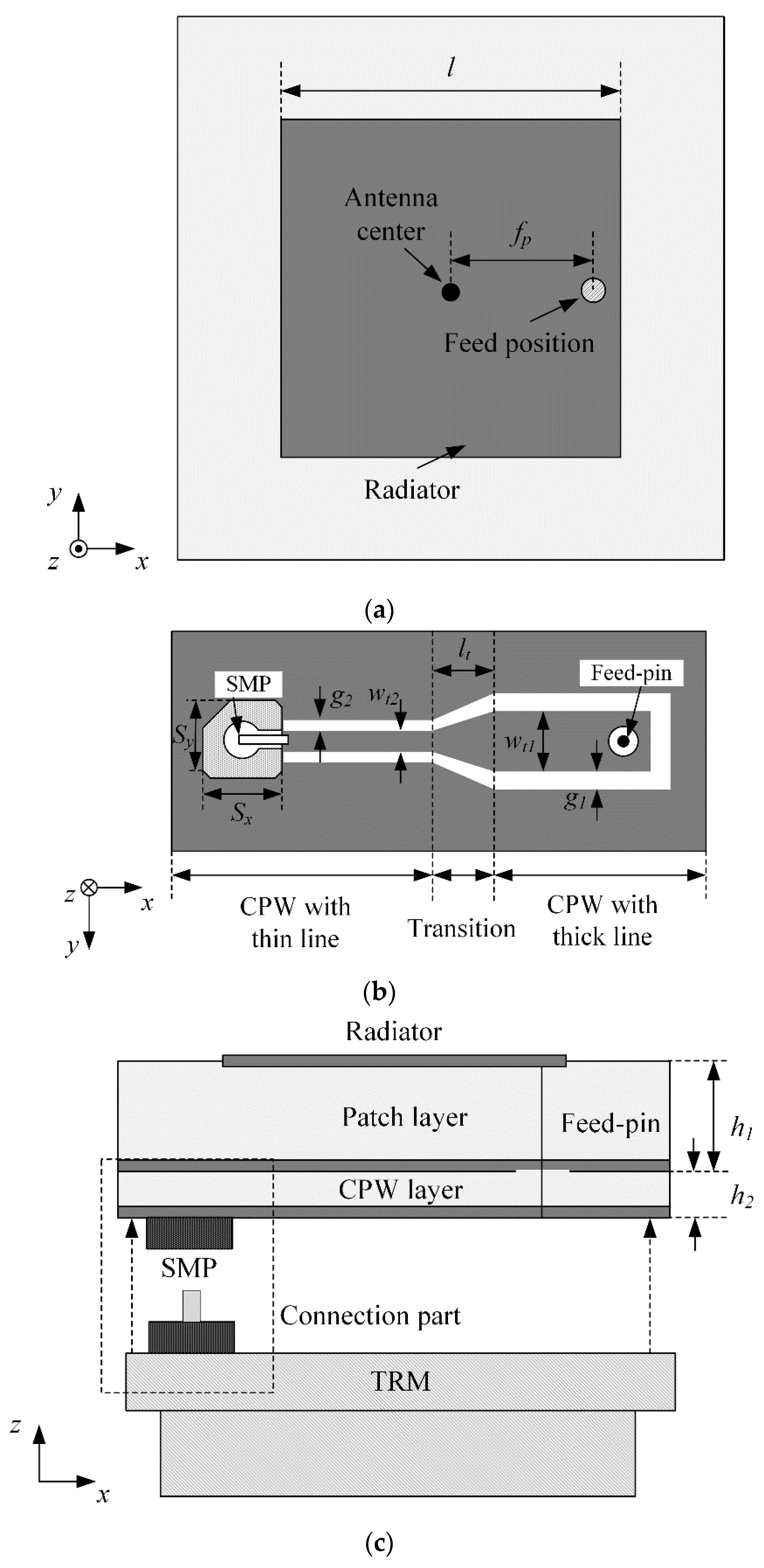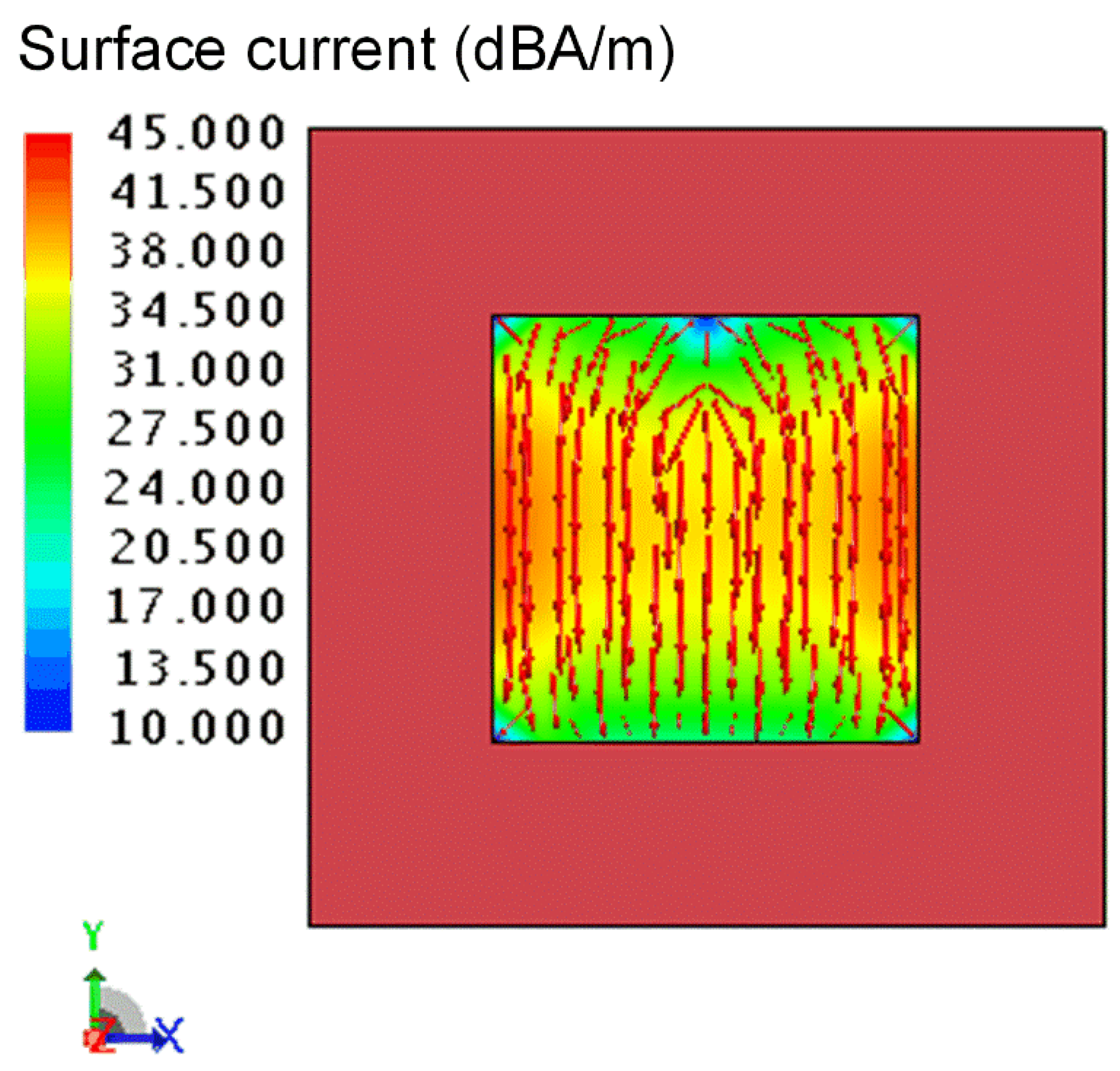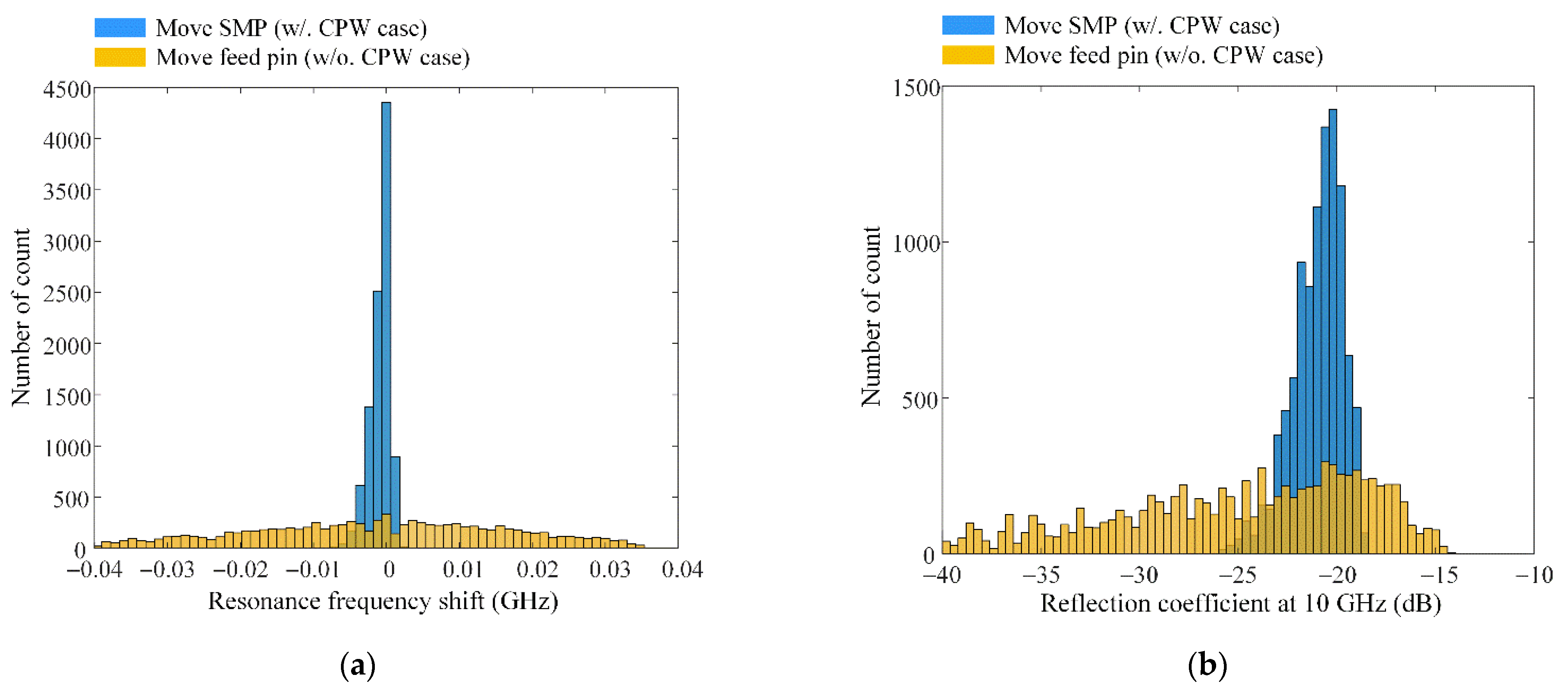Design of a High-Durability X-Band Patch Antenna with a CPW Feeding Network Based on a Durability Evaluation Analysis
Abstract
:1. Introduction
2. Proposed Antenna Design
3. Durability Evaluation Using Monte Carlo Simulations
4. Conclusions
Author Contributions
Funding
Acknowledgments
Conflicts of Interest
References
- Locker, C.; Vaupel, T.; Eibert, T.F. Radiation efficient unidirectional low-profile slot antenna elements for X-band application. IEEE Trans. Antennas Propag. 2005, 53, 2765–2768. [Google Scholar] [CrossRef]
- Dastkhosh, A.R.; Oskouei, H.D.; Khademevatan, G. Compact low weight high gain broadband antenna by polarization-rotation technique for X-band radar. Int. J. Antennas Propag. 2014, 2014, 1–10. [Google Scholar] [CrossRef]
- Zhou, Y.; Wang, T.; Hu, R.; Su, H.; Liu, Y.; Liu, X.; Suo, J.; Snoussi, H. Multiple kernelized correlation filters (MKCF) for extended object tracking using X-band marine radar data. IEEE Trans. Signal Process. 2019, 67, 3676–3688. [Google Scholar] [CrossRef]
- Wang, A.; Krishnamurthy, V. Signal interpretation of multifunction radars: Modeling and statistical signal processing with Stochastic Context Free Grammar. IEEE Trans. Signal Process. 2008, 56, 1106–1119. [Google Scholar] [CrossRef]
- Kwon, G.; Park, J.; Kim, D.; Hwang, K.C. Optimization of a shared-aperture dual-band transmitting/receiving array antenna for radar applications. IEEE Trans. Antennas Propag. 2017, 65, 7038–7051. [Google Scholar] [CrossRef]
- Li, H.-P.; Wang, G.-M.; Gao, X.-J.; Liang, J.-G.; Hou, H.-S. A novel metasurface for dual-mode and dual-band flat high-gain antenna application. IEEE Trans. Antennas Propag. 2018, 66, 3706–3711. [Google Scholar] [CrossRef]
- Eldek, A.A.; Elsherbeni, A.Z.; Smith, C.E. Wide-band modified printed bow-tie antenna with single and dual polarization for C- and X-band applications. IEEE Trans. Antennas Propag. 2005, 53, 3067–3072. [Google Scholar] [CrossRef]
- Alhalabi, R.A.; Rebeiz, G.M. High-efficiency angled-dipole antennas for millimeter-wave phased array applications. IEEE Trans. Antennas Propag. 2008, 56, 3136–3142. [Google Scholar] [CrossRef]
- Eldek, A.A. Ultrawideband double rhombus antenna with stable radiation patterns for phased array applications. IEEE Trans. Antennas Propag. 2007, 55, 84–91. [Google Scholar] [CrossRef]
- Khamsalee, P.; Mesawad, P.; Wongsan, R. Hybrid metamaterial for the secondary radar antenna system. J. Electromagn. Eng. Sci. 2020, 20, 221–233. [Google Scholar] [CrossRef]
- Luo, G.Q.; Hong, W.; Tang, H.J.; Chen, J.X.; Yin, X.X.; Kuai, Z.Q.; Wu, K. Filtenna consisting of horn antenna and substrate integrated waveguide cavity FSS. IEEE Trans. Antennas Propag. 2007, 55, 92–98. [Google Scholar] [CrossRef]
- Bilgic, M.M.; Yegin, K. Wideband offset slot-coupled patch antenna array for X/Ku-band multimode radars. IEEE Antennas Wirel. Propag. Lett. 2014, 13, 157–160. [Google Scholar] [CrossRef]
- Kong, D.K.; Kim, J.; Woo, D.; Yoon, Y.J. Broadband modified proximity coupled patch antenna with cavity-backed configuration. J. Electromagn. Eng. Sci. 2021, 21, 8–14. [Google Scholar] [CrossRef]
- Rana, B.; Lee, I.-G.; Hong, I.-P. Experimental characterization of 2 × 2 electronically reconfigurable 1 bit unit cells for a beamforming transmitarray at X Band. J. Electromagn. Eng. Sci. 2021, 21, 153–160. [Google Scholar] [CrossRef]
- Zahra, H.; Hussain, M.; Naqvi, S.I.; Abbas, S.M.; Mukhopadhyay, S. A simple monopole antenna with a switchable beam for 5G millimeter-wave communication systems. Electronics 2021, 10, 2870. [Google Scholar] [CrossRef]
- Wang, M.; Zhu, Q.; Chan, C.H. Wideband, low-profile slot-fed dipole-patch antenna and array. IEEE Antennas Wirel. Propag. Lett. 2020, 19, 2250–2254. [Google Scholar] [CrossRef]
- Ketavath, K.N.; Gopi, D.; Rani, S.S. In-vitro test of miniaturized CPW-fed implantable conformal patch antenna at ISM band for biomedical applications. IEEE Access 2019, 7, 43547–43554. [Google Scholar] [CrossRef]
- Li, X.-P.; Xu, G.; Ma, M.-R.; Duan, C.-J. UWB dual-band-notched lanky-leaf-shaped antenna with loaded half-square-like slots for communication system. Electronics 2021, 10, 1991. [Google Scholar] [CrossRef]
- Al-Gburi, A.J.A.; Ibrahim, I.B.M.; Zakaria, Z.; Ahmad, B.H.; Shairi, N.A.B.; Zeain, M.Y. High gain of UWB planar antenna utilising FSS reflector for UWB applications. CMC-Comput. Mater. Contin. 2021, 70, 1419–1436. [Google Scholar] [CrossRef]
- Jang, D.; Yoo, S.; Choo, H. Design of patch antenna with polarization control module to achieve broad 3-dB gain bandwidth over entire AR range. Microw. Opt. Technol. Lett. 2020, 62, 2606–2610. [Google Scholar] [CrossRef]
- Aboserwal, N.; Salazar-Cerreno, J.L.; Qamar, Z. An ultra-compact X-band dual-polarized slotted waveguide array unit cell for large E-scanning radar systems. IEEE Access 2020, 8, 210651–210662. [Google Scholar] [CrossRef]
- Haraz, O.M.; Elboushi, A.; Alshebeili, S.A.; Sebak, A.-R. Dense dielectric patch array antenna with improved radiation characteristics using EBG ground structure and dielectric superstrate for future 5G cellular networks. IEEE Access 2014, 2, 909–913. [Google Scholar] [CrossRef]
- George, E.; Das, D.; Osterman, M.; Pecht, M. Thermal cycling reliability of lead-free solders (SAC305 and Sn3.5Ag) for high-temperature applications. IEEE Trans. Device Mater. Reliab. 2011, 11, 328–338. [Google Scholar] [CrossRef] [Green Version]
- Zhang, L.-K.; Wang, Y.-X.; Li, J.-Y.; Feng, Y.; Zhang, W. Cavity-backed circularly polarized cross-dipole phased arrays. IEEE Antennas Wirel. Propag. Lett. 2021, 20, 1656–1660. [Google Scholar] [CrossRef]
- SMP-MSSB-PCS15T, Amphenol RF. Available online: https://kr.mouser.com/manufacturer/amphenolrf/ (accessed on 1 November 2021).
- FEKO EM Software, Altair. Available online: https://www.altair.co.kr/feko/ (accessed on 1 November 2021).
- Balanis, C.A. Antenna Theory Analysis and Design, 3rd ed.; John Wiley & Sons, Inc.: Hoboken, NJ, USA, 2005; pp. 811–883. [Google Scholar]
- Wang, Z.; Ling, C. Lattice gaussian sampling by Markov Chain Monte Carlo: Bounded distance decoding and trapdoor sampling. IEEE Trans. Inf. Theory 2019, 65, 3630–3645. [Google Scholar] [CrossRef] [Green Version]








| Parameter | Value (mm) |
|---|---|
| l | 9 |
| fp | 2.3 |
| h1 | 0.8 |
| h2 | 0.8 |
| g1 | 0.6 |
| g2 | 0.1 |
| wt1 | 1 |
| wt2 | 0.75 |
| lt | 0.85 |
| Sx | 5 |
| Sy | 5 |
| Characteristic | Case | Mean | Standard Deviation |
|---|---|---|---|
| Resonance Frequency | With CPW | 0 | 0.0014 |
| Without CPW | 0 | 0.0177 | |
| Reflection coefficientat 10 GHz | With CPW | −21 dB | 1.28 |
| Without CPW | −26.9 dB | 8.82 |
Publisher’s Note: MDPI stays neutral with regard to jurisdictional claims in published maps and institutional affiliations. |
© 2022 by the authors. Licensee MDPI, Basel, Switzerland. This article is an open access article distributed under the terms and conditions of the Creative Commons Attribution (CC BY) license (https://creativecommons.org/licenses/by/4.0/).
Share and Cite
Jang, D.; Lim, T.H.; Kim, D.; Wang, S.; Choo, H. Design of a High-Durability X-Band Patch Antenna with a CPW Feeding Network Based on a Durability Evaluation Analysis. Electronics 2022, 11, 553. https://doi.org/10.3390/electronics11040553
Jang D, Lim TH, Kim D, Wang S, Choo H. Design of a High-Durability X-Band Patch Antenna with a CPW Feeding Network Based on a Durability Evaluation Analysis. Electronics. 2022; 11(4):553. https://doi.org/10.3390/electronics11040553
Chicago/Turabian StyleJang, Doyoung, Tae Heung Lim, Dongyoon Kim, Sungsik Wang, and Hosung Choo. 2022. "Design of a High-Durability X-Band Patch Antenna with a CPW Feeding Network Based on a Durability Evaluation Analysis" Electronics 11, no. 4: 553. https://doi.org/10.3390/electronics11040553
APA StyleJang, D., Lim, T. H., Kim, D., Wang, S., & Choo, H. (2022). Design of a High-Durability X-Band Patch Antenna with a CPW Feeding Network Based on a Durability Evaluation Analysis. Electronics, 11(4), 553. https://doi.org/10.3390/electronics11040553






